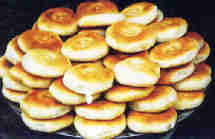Anytime and anywhere in Xinjiang Uygur Autonomous Region, tasty Nang is available in a variety of sizes. The flour-based food is the traditional staple for people of the Chinese Uighur minority, as well as residents of Kazakhstan, Uzbekistan, and Tatar. Nowadays, this ancient treat is increasingly popular among Han Chinese.
A piece of nang made during the Tang dynasty was excavated in Tulufan, and displayed at the Museum of Xinjiang. It is round, like the nang made today, and proves that the dish could be found on dinner tables in Xinjiang as far back as 1,000 years ago.
The main ingredient of nang is flour, and sometimes cornmeal. Nang is baked in a round shape, in different sizes, "Aimaneke", the largest kind, is thin and crisp in the center with a thick soft crust, and is often as big as 40-50 centimeters in dismeter. Each aimenke nand requires one kilogram of flour, prompting its nickname as the "king of nang". The thinnest nang, "tuokexi", just one centimeter thick, is really a culinary work of art. Whereas the thickest nang, "jierde nang", can be 5 to 6 centimeters thick and more than then centimeters indiameter. Because of the tiny holes poked in the center, the people of Han
ethnic group called it "wowo", which means, "hole". You can find the delicious golden-brown jierde nang in Kashgar. All these varieties of nang are usually made of leavened flour. There is also a kind of oily nang made of unleavened flour mixed with oil or suet. Because of its taste, brittleness and crispness, it is often served on holidays and other special occasions. Salty water can be added during the baking; sometimes it is replaced by syrup. The crystal syrup gives the baked "sweet nang" a shiny appearance and a unique flavor.

Many ingredients can be used to make nang: flour, sesame, onion, eggs, oil, milk, salt and sugar are used for the "vegetarian" kind. Meat-eaters may prefer nang made with fresh minced mutton, oil, salt and onion.
The process of baking nang is also one-of-a-kind. Almost every Uighur family has a nang baking pit - sometimes several families use a single one -and the size of each pit depends on the number of people in each family. A nang pit looks like an ordinary hearth, with a height ranging from less than a meter to two meters. It is square outside, and round and hollow inside, like a drum. As soon as the pit is red and ready, the nang dough is rolled into balls which are flattened into pancakes by the cook with a small roller. The cook then places the pancake in a mold, and tops it off with salt and sesame dressing. With a flip of his hand, the cook can toss a nang cake onto the wall of the pit. The common firewood for nang baking is pine or cypress, but connoisseurs may prefer the flavor of "suosuo", a shrub. Nang baking pits can also be used to cook mutton or gigot.
The minority ethnic groups in Xinjiang, especially the Uighur people, like to fry nang mixed with meat in an iron pot, or prepare it in a steamer. Hot ashes are also used to make parched nang, which has a particular flavor. Some Uighurs in southern Xinjiang bake nang called "Wuqiake" (hearth) nang with the remaining heat on the walls of ordinary hearths after they boil tea and cook meals. Wuqiake nang is generally very thin, but delicious.
People of Xinjiang like to have a bit of tea with nang before breakfast, lunch and supper. In the past, it was prepared for people going off on long trips. When a husband was about to leave home on a lengthy journey, his wife would bake a nang the size of a basin the evening before he set out. In the early morning of the day he left, she cut the nang into pieces and put them into her husband's bag. In desert or gobi areas, the unspoilable nang is an excellent food to have along. It is said that Tangseng, the famous monk in the Tang Dynasty took nang with him when he traveled in the west.

Nang plays a very important role in the lives of Uighur people. The custom of the wedding couples sharing a salty nang is still followed today. During a wedding ceremony, the host gives a bowl of salty water and a piece of Nang to each the bridegroom and bride. Eating the nang with salty water together symbolizes their promise to stay together for better or worse. Nang is also expected when guests come calling. If you are invited to the home of a Uighur family in Kuche County, the host will pile nangs of various sizes in the middle of the room, and motion for you to chow down.
How did the herdsmen who were far from home much of the year preserve their nang? It is said that when they passed the Kariz well, they threw the hardened nangs into it. Then following the direction the water-flow, they herded their livestock to the next well and retrieved their water-soaked nangs, soggy but still good to eat. Plain nang has a fine flavor, but after a taste of nang with mutton, you will realize why nangbao rou (mutton wrapped in nang) and yang rou pao mo (crumbled unleavened bread in lamb stew) are so popular. If your taste buds are truly tempted, try this: nang mixed with Xinjiang watermelon and Hami honeydew melon. We guarantee you'll be pleasantly surprised!













